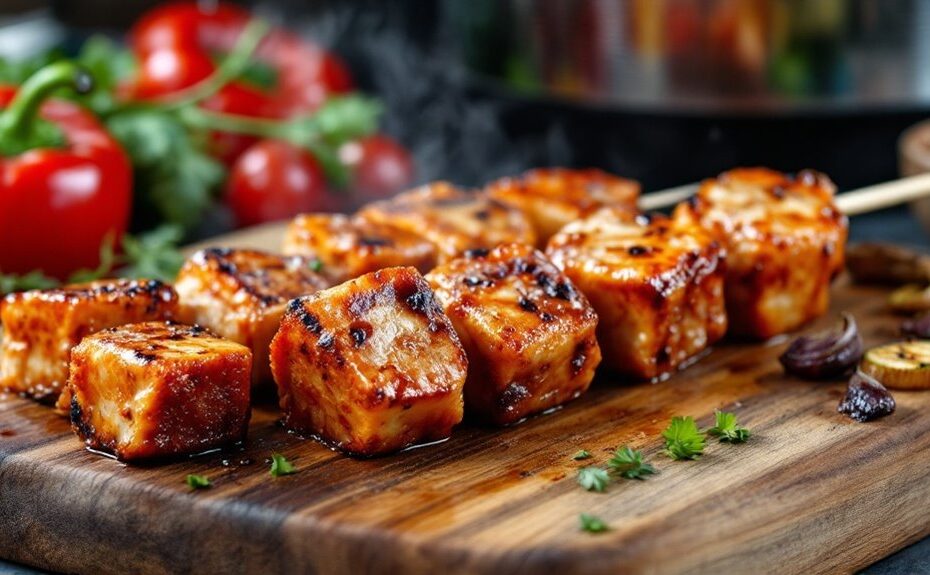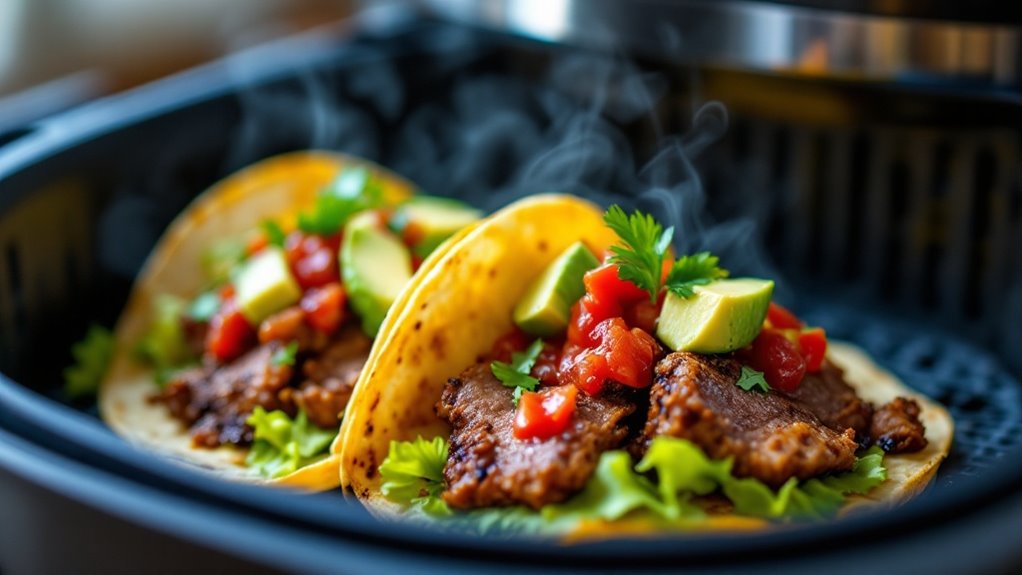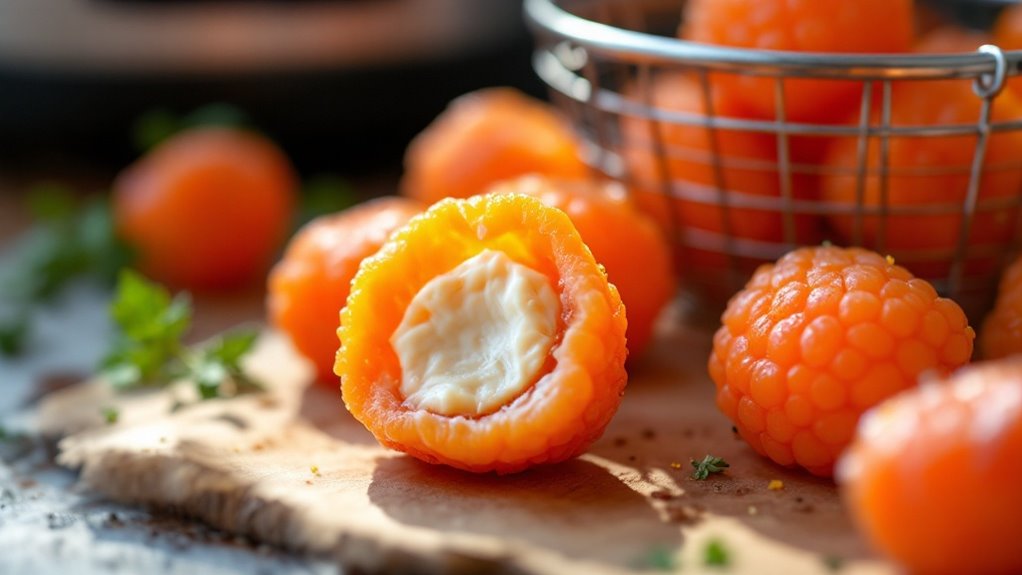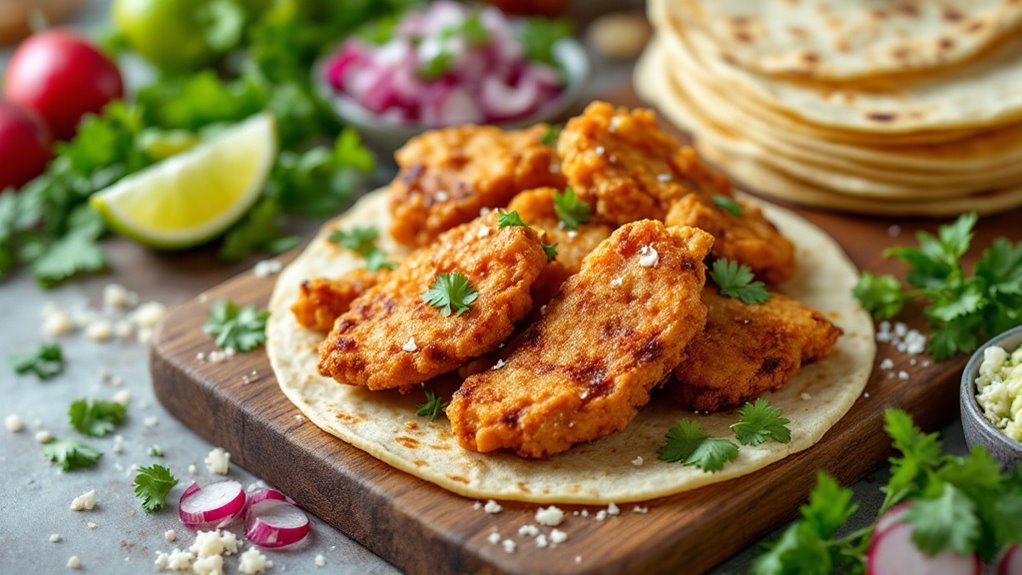Kangaroo meat, a lean protein with 98% less fat than beef, is gaining popularity for its unique flavor and health benefits. To make air fryer kangaroo kebabs, you'll need to marinate the meat with a blend of olive oil, garlic, lemon juice, rosemary, and honey, ensuring it soaks up the flavors for at least two hours. Once threaded onto skewers with fresh vegetables, the kebabs cook quickly in the air fryer, but the key lies in achieving the perfect balance of tenderness and char. Discover how to master this dish and elevate your next meal with a protein that's both exotic and nutritious.
Key Takeaways
- Marinate kangaroo meat in olive oil, garlic, lemon juice, rosemary, and honey for 2+ hours to tenderize and enhance flavor.
- Assemble kebabs by alternating marinated kangaroo cubes with vegetables like bell peppers, red onions, and zucchini on skewers.
- Preheat air fryer to 400°F (200°C) and cook kebabs for 10-12 minutes, flipping halfway for even browning.
- Check doneness with a meat thermometer: 145°F (63°C) for medium-rare or 160°F (71°C) for medium.
- Serve kebabs with sides like salad, roasted vegetables, or dipping sauces, and store leftovers in the fridge for up to 3 days.
Gather Your Ingredients
Before you begin, make sure you've got all the ingredients ready to go. Start with ingredient sourcing: choose fresh kangaroo meat from a trusted supplier, guaranteeing it's lean and sustainably sourced. Pair it with vibrant vegetables like bell peppers, red onions, and zucchini for a colorful mix. Don't forget garlic, olive oil, and a blend of spices—think smoked paprika, cumin, and a hint of chili for depth. For ingredient preparation, wash and chop your veggies into uniform pieces to guarantee even cooking. Pat the kangaroo meat dry and set it aside; you'll handle it in the next step. Gather skewers—metal or soaked wooden ones—and preheat your air fryer. Having everything prepped and within reach streamlines the process, so you're ready to assemble and cook efficiently.
Prepare the Kangaroo Meat
Start by selecting fresh kangaroo cuts, ideally lean and tender, to guarantee the best texture for your kebabs. Trim any excess sinew or fat, then slice the meat into uniform cubes for even cooking. Marinate the pieces in a blend of olive oil, garlic, lemon juice, and your choice of herbs to infuse them with rich, savory flavor.
Select Fresh Kangaroo Cuts
When selecting fresh kangaroo cuts for kebabs, opt for lean, tender portions like the loin or fillet, as they'll cook evenly and stay juicy in the air fryer. Prioritize kangaroo sourcing from reputable suppliers who adhere to ethical and sustainable practices, guaranteeing high-quality meat. For meat selection, inspect the cuts for a deep red color and firm texture, avoiding any with excessive fat or discoloration. Trim away any silver skin or connective tissue to enhance tenderness. Since kangaroo is naturally low in fat, choose cuts that are uniform in size for consistent cooking. Proper meat selection secures your kebabs will be flavorful and tender, making the most of this unique protein. Freshness is key, so use the meat within a day or two of purchase for peak results.
Marinate for Enhanced Flavor
Once you've selected your fresh kangaroo cuts, marinating is the next step to infuse the meat with depth and complexity. Combine olive oil, garlic, rosemary, lemon juice, and a touch of honey in a bowl to create a balanced marinade. Coat the kangaroo pieces evenly, guaranteeing every bite absorbs the flavors. For peak flavor infusion, let the meat marinate for at least 2 hours, though overnight in the fridge yields the best results. The acidity tenderizes the lean meat while the herbs and spices enhance its natural richness. Avoid over-marinating, as kangaroo's delicate texture can break down. Pat the meat dry before skewering to secure a perfect sear in the air fryer. This step transforms your kebabs into a harmonious blend of savory and aromatic notes.
Marinate for Maximum Flavor
To access the rich, gamey flavors of kangaroo meat, marinating is essential. Start by cutting the meat into even cubes, guaranteeing they're uniform for consistent flavor infusion. Combine olive oil, garlic, lemon juice, rosemary, and a touch of honey in a bowl to create a balanced marinade. Submerge the kangaroo pieces, coating them thoroughly, and let them rest in the fridge for at least 4 hours—overnight is ideal for deeper marinate time. The acidity tenderizes the lean meat while the herbs and spices penetrate, enhancing its natural taste. Avoid over-marinating, as kangaroo's delicate texture can break down. Pat the meat dry before cooking to secure a perfect sear. This step locks in moisture and amplifies the bold, earthy notes unique to kangaroo.
Assemble the Kebabs
Thread the marinated kangaroo pieces onto skewers, alternating them with your choice of vibrant veggies for a balanced presentation. Make sure each kebab is tightly packed but not overcrowded, allowing even cooking in the air fryer. Secure the ends with a gentle twist to prevent ingredients from slipping off during the cooking process.
Skewer the Ingredients
After preparing your kangaroo pieces and vegetables, grab your skewers and begin assembling the kebabs. Choose skewer types wisely—metal skewers are durable and reusable, while bamboo skewers should be soaked in water for 30 minutes to prevent burning. Thread the ingredients carefully, guaranteeing even spacing to promote uniform cooking. Start with a chunk of kangaroo, followed by a vegetable piece, repeating the pattern until the skewer is full. Leave about an inch at each end for easy handling. Pay attention to skewer safety by avoiding overcrowding, which can lead to uneven cooking or breakage. If using metal skewers, handle them with care to avoid burns. Secure the ingredients firmly but gently to maintain their shape during air frying. This step makes certain your kebabs cook evenly and look appetizing.
Alternate Meat and Veggies
When assembling the kebabs, alternate between kangaroo meat and vegetables to secure a balanced flavor and texture in every bite. If you're using kangaroo substitutes like beef, venison, or lamb, make certain they're cut into uniform cubes for even cooking. Pair them with vegetable alternatives such as bell peppers, zucchini, cherry tomatoes, or red onions, which add vibrant color and complementary flavors. Thread the ingredients onto skewers in a repeating pattern—meat, veg, meat, veg—to create a harmonious blend. This method confirms each bite delivers a mix of savory and fresh notes. Avoid overcrowding the skewers; leave a small gap between pieces to promote air circulation in the air fryer. Precision in assembly enhances both presentation and taste, making your kebabs a standout dish.
Secure Kebab Ends
To guarantee your kebabs hold together during cooking, start by securing the ends of each skewer. Push the meat and veggies tightly toward the base, leaving about an inch of space at the top and bottom. This assures kebab safety by preventing ingredients from slipping off during air frying. Use a small piece of meat or a sturdy vegetable, like a chunk of onion, to anchor the ends. If your skewers are metal, make certain they're smooth to avoid tearing the ingredients. For wooden skewers, soak them in water for 30 minutes beforehand to prevent burning. Double-check that each skewer is evenly loaded and secure before placing them in the air fryer. Properly assembled kebabs not only cook evenly but also make flipping easier.
Preheat the Air Fryer
Before you assemble the kebabs, preheat your air fryer to 400°F (200°C) to guarantee even cooking and a crisp exterior. Proper air fryer settings are vital for achieving the perfect texture, so verify your temperature control is accurate. Most air fryers heat up quickly, but allow 3-5 minutes for the unit to reach the desired temperature. This step guarantees the kebabs cook uniformly and develop a golden-brown sear. If your air fryer has a preheat function, use it; otherwise, set the timer manually. Avoid overcrowding the basket during preheating, as this can disrupt airflow and temperature consistency. Double-check the temperature display to confirm it's stable before proceeding. Preheating sets the stage for perfectly cooked kangaroo kebabs, locking in moisture while creating a satisfying crunch.
Cook the Kebabs to Perfection
With the air fryer preheated to 400°F (200°C), arrange the kangaroo kebabs in a single layer in the basket, making sure they aren't touching to promote even airflow. Set the cooking time to 10-12 minutes, flipping the kebabs halfway through to guarantee even browning and tenderness. Maintain precise temperature control to prevent overcooking, as kangaroo meat is lean and can dry out quickly. Use the air fryer's rapid circulation to achieve a crisp exterior while keeping the interior juicy. Adjust the cooking time slightly if your kebabs are thicker or thinner than average. Avoid overcrowding the basket, as this can disrupt airflow and lead to uneven cooking. The high heat will sear the meat, locking in flavors and creating a perfect balance of texture and taste.
Check for Doneness
Once the kebabs have cooked for the recommended time, carefully remove one from the air fryer and check for doneness by slicing into the thickest part of the meat. Use a meat thermometer to measure the internal temperature, aiming for 145°F (63°C) for medium-rare or 160°F (71°C) for medium. Kangaroo meat is lean, so overcooking can dry it out. Look for visual cues like a slightly pink center for medium-rare or a uniform brown color for medium. The juices should run clear, not red. If the meat isn't done, return the kebabs to the air fryer and cook in 1-2 minute increments, checking frequently. Avoid overhandling the skewers to prevent the meat from drying out. Precision guarantees tender, flavorful kebabs every time.
Serve With Your Favorite Sides
While the kangaroo kebabs rest, take the opportunity to prepare or plate your favorite sides to complement their rich, gamey flavor. Opt for side dishes that balance the bold taste, such as a crisp green salad with a tangy vinaigrette or roasted root vegetables drizzled with honey and thyme. For a revitalizing contrast, pair the kebabs with a zesty quinoa or couscous salad packed with fresh herbs and citrus. Creamy mashed sweet potatoes or a light coleslaw also make excellent pairing options, adding texture and depth to your meal. Don't forget to include a dipping sauce, like a smoky barbecue or garlic aioli, to elevate the experience. Thoughtfully chosen sides will enhance the kebabs' unique flavor, creating a well-rounded, satisfying dish.
Tips for Storing and Reheating
To guarantee your kangaroo kebabs retain their flavor and texture, proper storage and reheating are key. For storage tips, let the kebabs cool completely before placing them in an airtight container. Refrigerate for up to 3 days or freeze for up to 2 months, separating layers with parchment paper to prevent sticking. When reheating methods are needed, use your air fryer for the best results. Preheat to 350°F (175°C) and reheat for 3-5 minutes, flipping halfway through. If frozen, thaw in the fridge overnight before reheating. Avoid microwaving, as it can dry out the meat. For a quick refresh, lightly brush the kebabs with oil before reheating to restore moisture. These steps make certain your kebabs stay succulent and delicious, even after storage.
Disclosure: As an Amazon Associate, I earn from qualifying purchases.



